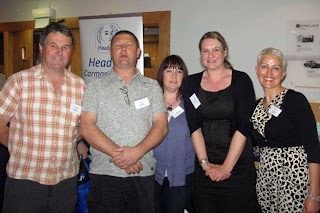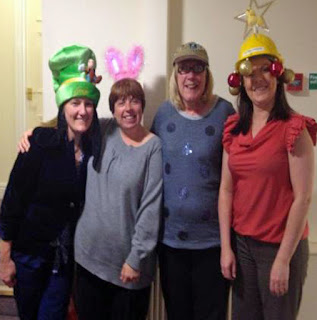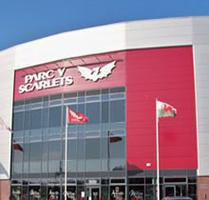Blogs
The Pembrokeshire branch of Headway, the brain injury association, is getting ready for a busy summer schedule.
Top of the agenda will be a major Headway Wellness Day at the National Botanic Garden of Wales in Llanarthne, near Carmarthen, in September.
We have been doing a lot of work to spreading the word about Headway, particularly since the national Brain Injury Awareness week earlier this year, said Rebecca Proctor, the treasurer of the Pembrokeshire branch of Headway.
The association works as a registered charity and works very hard to raise awareness of what support is available to brain injury victims and their families.
It is estimated that across the UK there are around 500,000 people (aged 16 - 74) living with long term disabilities as a result of traumatic brain injury.
Some of the members of the Pembrokeshire branch of Headway attended the recent South and West Wales brain injury Conference in Swansea.
The event included a number of excellent guest speakers and gave members of Headway the chance to learn more about the effects of brain injury and to listen to some inspirational stories from people who who have experienced head injuries.
Members of Pembrokeshire Headway have recently enjoyed visits from guest speakers to the associations meeting HQ at Haverfordwest Rugby Club.
Speakers have included Dr Tracey Ryan Morgan and Roger Weddell, consultant neuro-psychologists who lead group discussions on living positively with brain injury.
Forthcoming events for the group include the annual summer BBQ and a boat trip.
A West Wales training day is scheduled for Wednesday, July 17, with the likely venue being in Carmarthen.
The national Headway association will be running a conference in Nottingham on July 12-14.
New members are warmly welcomed to meetings of the Pembrokeshire branch of Headway. Meetings are the second Thursday of each month at Haverfordwest Rugby Club, 6.30 pm. For further information please call Barbara Moules on 01348875313
Meanwhile, staff at West Wales legal firm QualitySolicitors Redkite and Cardiff legal firm Slater and Gordon have been busy raising funds for Pembrokeshire Headway. A recent fund-raiser saw staff wear silly hats for Hats for Headway Day.
Both QS Redkite and Slater and Gordon (supporters of Pembrokeshire Headway), along with other firms and other South and West Wales branches of Headway, are contributing 250 a piece towards the cost of the Headway Wellness Day which will be held at the National Botanic Garden of Wales on September 7.
Weblinks
https://www.facebook.com/headway.pembrokeshire
http://www.qualitysolicitors.com/redkite
http://www.slatergordon.co.uk/contact-us/cardiff/
https://www.headway.org.uk
http://www.gardenofwales.org.uk/
Pictured at the South and West Wales brain injury Conference in Swansea are members of Pembrokeshire Headway branch Jo and Kevin Patterson and Andrew Davies, together with Rebecca Proctor of QS Redkite (treasurer) and Bethan Drinkall, specialist neuro-physiotherapist from Equinox rehabilitation.
Staff at QS Redkite wore silly hats for Hats for Headway Day to raise money for Headway.
The next meeting of theRugby Business Network in Llanelli will be held onTuesday 9th July 2013
The July meeting of Llanelli Rugby Business Network marks the second anniversary of this popular event and will again be held at the Scarlets Heart and Soul Caf, Parc y Scarlets.
The event is friendly and mainly informal and all attendees will be provided with the opportunity of introducing their business, the services they offer and the type of leads and introductions they are seeking, plus there will be ample opportunity for informal networking.
The first speaker will be Amanda Russell (a regular attendee of RBN), who is employed as an accountant, at Clay Shaw Butler, Carmarthen.
The Rugby Business Network team are also currently in discussions regarding inviting a special guest speaker along to mark this landmark occasion.
Tickets are now on sale for the second Llandeilo Jazz Festival, which takes place over the weekend of Friday July 5 to Sunday July 7.
The cost of two weekend wristband passes is just 3. To ensure entrance to the festival, those wishing to attend should register online at www.jazzatllandeilo.co.uk
The festival is presented by the award-winning Evan Evans Brewery of Llandeilo, who are donating funds to the music programme at Llandeilos two primary schools, both of which also appear as part of the community/street music entertainment which is open to all.
The 2013 Festival
After a succesful launch year, the festival has doubled in size and has 40 events on four stages across three venuesin the heart of town - The Cawdor Hotel, The Angel and The White Horse Inn.
The upbeat line up has a strong representation of the Welsh Jazz community and covers a wide jazz spectrum including Mainstream, Traditional, Big Band, Ragtime, Jazz Rock, Funk, Gypsy Jazz and Blues.
The Festival includes feature performances by:
Willie Garnett - Big Band Leader and one of the UK's leading sax players
Kent Duchaine - Delta Blues Legend from the USA
Oli Nezhati - Llandeilo born rising star of the London Jazz Scene
The Dave Cottle Trio - Swansea Jazzland's much admired house trio - with special guests
Remi Harris - Young Gypsy Jazz guitar sensation
There is also a special event entitled A Tribute to Derek Watkins, The Sound of James Bond
Derek who passed away in march this year was a leading Trumpeter and much loved Band Leader.
How to reserve your pass
Register for your 3 weekend wristband as soon as possible at www.llandeilojazz.co.uk
On or about 21st June 1404, Owain Glyndwr held his first Parliament, at Machynlleth and at which he was Crowned Prince of Wales.
This followed a successful campaign of around four years, in which Glyndŵr had liberated most of Wales and brought an end to Anglo - Norman colonisation, with major victories in 1401 at the Battle of Hyddgen, 1402 at the 'Battle of Bryn Glas' and in 1403 at the'Battle of Bryn Owen - Stalling Down'.
On 21st June 1234, the Peace of Middle was agreed between Llywelyn ab Iorwerth (Llywelyn Fawr) and King Henry III of England.
Llywelyn ab Iorwerth was born at Dolwyddelan castle in around 1173 and by 1200, he had taken control of the kingdoms of Gwynedd and Deheubarth and began to use the title of 'Prince of the whole of North Wales'. Llywelyn then concluded a treaty with King John of England in 1201, in which John recognised Llywelyn's territorial gains in return for Llywelyn's fealty to him. Llywelyn then married King John's daughter, Joan in 1205 and when Gwenwynwyn of Powys was stripped of his lands by John, Llywelyn took advantage and claimed most of Powys. Llywelyn also fought with John against King William I of Scotland.
However in 1211, Llywelyn and John fell out, which resulted in John invading Gwynedd with an alliance of almost all the other Welsh princes. Total defeat, however, was avoided by Joan's intervention, who managed to convince her father not to take all of Llywelyn's lands. He was however restricted to the land west of the Conwy.
During 1212 and 1213, Llywelyn in alliance with the lords of Powys and Deheubarth, was able to regain much of his lost lands and in 1215 the alliance also took the castles of Carmarthen, Kidwelly, Llanstephan, Cardigan and Cilgerran. Llywelyn, as leader of the alliance, was now the ruler of the majority of Wales and in 1216 at Aberdyfi, the other princes confirmed their allegiance to Llywelyn.
In 1218, Llywelyn's possessions were confirmed by John's successor Henry III at the Treaty of Worcester and he instigated a programme of castle building such as those at Criccieth, Dolwyddelan, Castell Y Bere and Tomen Y Bala. On the whole, there remained good relations between Llywelyn and Henry III, which was confirmed in 1234 with The Peace of Middle, initially only to last for two years, it did actually extend until Llywelyn's death in 1240.
Celtic Festivals
Summer Solstice
The summer solstice is the first day of astronomical summer and the longest day of the year for people in the Northern Hemisphere. In ancient times, solstices and equinoxes were important in helping people to maintain calendars and grow crops. The solstice itself has remained a special moment of the annual cycle of the year since Neolithic times and over the centuries has been marked by festivals and celebrations.
* In Wales prehistoric sites such as at Bryn Celli Ddu on Anglesey, the open burial chamber dated to around 2000BC, is so perfectly aligned that for only 20 minutes each year, a beam of sunlight aligns exactly with the opening to the chamber.
* Mistletoe was important to the Celtic Druids as it was believed to cure all ills. On Midsummer Eve, it is reported that they would cut it with a golden scythe and catch it in a cloth before it touched the ground.
* With the coming of Christianity, people were encouraged to give up their old traditions, by their incorporation into new Christian practices. For example, the summer solstice became known as the feast of St. John, the Baptist.
* In Wales it is called Gŵyl Ifan Ganol Haf (St John's of Midsummer). Great agricultural fairs, which included dancing, merriment and the lighting of bonfires, were held at this time. Welsh tradition says that gathering Saint John's Wort on the night before the summer solstice would bring good luck and imbue it with extra healing powers.
* A sprig of mistletoe gathered on Midsummer Eve and placed under the pillow was said to bring prophetic dreams and branches from birch trees were used to decorate maypoles town squares.
.
* With the advent of non-conformist beliefs on the Welsh socio-political culture, this (among so many other similar festivals) suffered greatly, and its observance finally died out by the end of the 19th century.
On 21st June 1792, Iolo Morganwg organised the first Gorsedd of Bards at Primrose Hill, London, (photograph shows a plan of the Gorsedd Circle in Iolo Morganwg's handwriting, note that "'the Bards stand unshod and uncovered within the circle")
Iolo Morganwg, an academic originally from Llancarfan in Glamorgan, living in London, believed that Celtic Welsh culture and heritage needed to be promoted and arranged the first Gorsedd in a ceremony at Primrose Hill, London, on 21st June 1792 (supposedly based on the activities of the ancient Celtic Druidry). An outer circle of small stones was formed and a larger Gorsedd Stone placed in the centre and only the Bards, barefoot and bareheaded and identified by their green, blue or white ribboned armbands, were permitted to enter. Several further ceremonies were held in London and in 1795 Iolo returned to Glamorgan to hold his first Gorsedd in his native country. However, the authorities believed that he was encouraging revolutionary activity and it was not until 1815 that Gorseddau were able to flourish properly.
It was later discovered to a fantasy of Iolo's imagination, but the institution he established, was cherished by Welsh people, who saw it as a means of promoting a distinct Welsh culture and in 1819, the Gorsedd was formally linked with the National Eisteddfod.
The National Gorsedd of Wales, "Gorsedd Beirdd Ynys Prydain" ("The Gorsedd of Bards of the Island of Britain") is an association of individuals who have made a significant and distinguished contribution to Welsh culture and it supports Welsh literatue, music and poetry in particular. Its activity is most visible at The National Eisteddfod
* Gorsedd Beirdd Ynys Prydain was founded in 1792 by Iolo Morganwg, who also invented much of its ritual, supposedly based on the activities of the ancient Celtic Druidry.
* The Gorsedd y Beirdd made its first appearance at the Eisteddfod at the Ivy Bush Inn in Carmarthen in 1819, and its close association with the Festival has remained.
* There are three equal ranks of membership in the Welsh Gorsedd. Ovates who wear green robes, Bards who wear blue robes, and Druids who wear white robes.
* The concept of the three roles of bards, ovates and druids is thought to originate from the writings of the ancient Greek historian and geographer Strabo, the "bardoi" being the poets and singers, the "o'vateis", the specialists in the natural world and the "druidai" who studied moral philosophy.
* The head of a Gorsedd known as an Archdderwydd (Archdruid) wears a golden robe, is elected for a term of three years and is responsible for conducting the Gorsedd ceremonies during Eisteddfod week. To become an Archdruid, an individual must have won one of the Eisteddfod's three highest awards: the Crown, the Chair, or the Literature Medal. * Often a new inductee will take a pseudonym or bardic name.
* During these ceremonies, the Archdruid and the members of the Gorsedd gather on the Eisteddfod stage and when the Archdruid reveals the identity of the winning poet, the 'Corn Gwlad' (a trumpet) is played and the Gorsedd Prayer is chanted. The Archdruid then partially withdraws a sword from its sheath three times, and cries "A oes heddwch?" ("Is there peace?"), to which the assembly reply "Heddwch" ("Peace"). Then the Archdruid drinks from Horn of Plenty and is presented with a basket of 'flowers, after which a floral dance is performed
* The triple line symbol called "awen" ( /|\) representing the sun, is commonly used to represent a Gorsedd.
Cadwgan of Llandyfai was consecrated Bishop of Bangor on 21st June 1215
Cadwgan was the son of a Welsh woman and an Irish priest, famous for his excellent preaching abilities. He entered monastic life immediately he reached adulthood and was successively Abbot of Strata Florida and Whitland Abbey (from 1203) in Carmarthenshire.
He appears to have been something of a dodgy character and was removed from office at Whitland during fraud investigations into wool sales by a party from Clairvaux. However, in 1215, Cadwgan managed - probably with the help of Prince Llywelyn the Great - to gain appointment to the vacant see of Bangor before the Archbishop of Canterbury was made fully aware of the situation. He was consecrated at Staines on 21st June. His episcopacy seems to have been unremarkable, although he was a famous theologian and wrote a number of spiritual tracts and commentaries, as well as a penitential, while in office.
He was also known for his charitable works and, in 1234, imported a shipload of corn from Ireland to feed the poor of his diocese. After twenty-one years, Pope Gregory IV gave him permission to retire, as an ordinary monk, into the Abbey of Dore, in Herefordshire. He gave the monastery there all his goods, including his horses and a fine library of books. However, he does not appear to have been very popular and, towards the end of his days, the Chapter heard accusations of his neglecting the Cistercian observances, particularly breaking their silence. Probably, he had been allowed some latitude due to his previous status, thus incurring jealousy amongst his fellows. Cadwgan died in 1241 and was buried at Dore Abbey under a wooden effigy of him in full Episcopal regalia.
The Taff Vale Railway Company was created on 21st June 1836 by an Act of Parliament that also capped the speed of trains to 12 mph.
The first stretch of the line to be opened was that from Cardiff to Navigation House (later named Abercynon) on October 9th 1840, with the line extended to Merthyr on April 12th 1841. The chief engineer was Brunel and initially he used a narrow gauge, single line track, because of the narrowness of the Taff valley and trains were only able to pass at stations. The line, however, was upgraded to a double line in 1857. One of the notable features of the line is the 110-foot span, skew stone arch viaduct at Pontypridd, which is still in use today.
Born on this day 1845 in Merthyr.
Sir Samuel Walker Griffith . Principal author of the Constitution of Australia, politician and Chief Justice of the High Court of Australia.
Griffith's family migrated to Queensland when he was eight and after finishing school and university, he travelled Europe spending much of his time in Italy. On his return, he studied law and became involved in politics and as leader of the liberal party he was elected Premier of Queensland 1n 1883. He was regarded as a liberal reformer, he opposed the use of Kanaka slave labour and introduced a bill to legalise trade unions. However his government used the military to break the great shearers' strike, and he earned the nickname "Oily Sam". On his return to his legal career, he was appointed as Chief Justice of the Supreme Court of Queensland, before becoming the first Chief Justice of the High Court of Australia in 1903. Griffith died in 1920 and was commemorated by the naming of Griffith University in South East Queensland.
Born this day 1964 in Swansea.
Dean Saunders - Former Wales soccer international, capped 75 times, scoring 22 goals - making him one of the nation's highest scoring and most capped players of all time. Following his retirement from playing, he has managed of Wrexham, Doncaster Rovers and Wolverhampton Wanderers.
One of the great Welsh fighters who is all too often forgotten is Johnny Basham of Newport, the 'Happy Wanderer' who became the welterweight British champion, joining his fellow countrymen, Jim Driscoll, Tom Thomas, Freddie Welsh and Jim Driscoll who had also earned Lonsdale Belts at their respective weights.
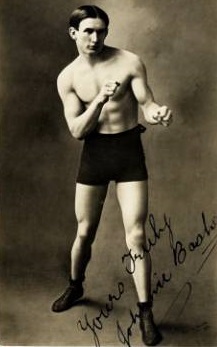
By the time his career ended he had won the British and the European championship at two different weights. Like so many boxers from South Wales, Basham first found his punch on the boxing booths that would travel around the country, after proving himself a capable scrapper on the streets of Newport. Known for his elegance and artistry as a ring stylist, Basham was a close friend of 'Peerless' Jim Driscoll, and both would travel great distances in WW1 to entertain the troops stationed throughout France with displays of their boxing prowess.
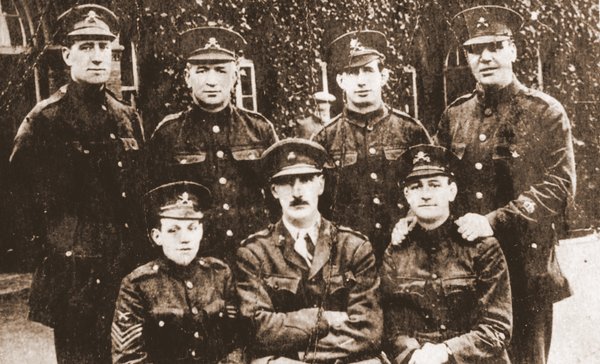 Johnny Basham in WW1 Boxing Squad (2nd from right, back row). Jimmy Wilde (front row left) and Jim Driscoll (front row right) can also be seen in the picture
Johnny Basham in WW1 Boxing Squad (2nd from right, back row). Jimmy Wilde (front row left) and Jim Driscoll (front row right) can also be seen in the picture
In later years, after his career in the ring had passed, Johnny Basham struggled to find an alternative to boxing and fell on hard times. Never one to wallow in his misfortune, he remained a upbeat and likable character known for his love of a good joke. The people of Newport did not forget Johnny's days of glory, and in 1947 a boxing tournament was arranged in the hope that the proceeds of the event would provide Johnny with a pension.
 Johnny's Lonsdale Belt - could belong to Wales for 30,000
Johnny's Lonsdale Belt - could belong to Wales for 30,000
Sadly, just a week before the tournament, Johnny Basham died, with a huge crowd turning out for the funeral. Sufficient funds were not available to mark Johnny's grave in a manner befitting such a great champion, and his resting place was marked with a simple wooden cross for forty years.
In 1987 a boxing tournament between Newport and its German twinned town Heidenheim helped raise the money for a headstone.
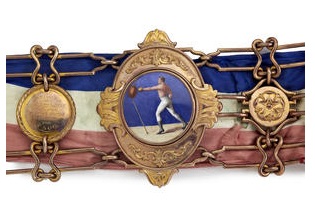
The Lonsdale Belt, which was awarded to Basham in 1914, 1915 and 1916, was auctioned at Bonhams Sporting Memorabilia sale yesterday in Chester, but failed to reach its reserve price of 30,000.
It seems a shame that this information does not seem to have reached any Welsh institution that might have been able to raise the funds to purchase the belt so that this amazing piece of Welsh boxing history could remain in the country and be viewed by the public, possibly the National Museum of Wales or possibly the Newport City Council to be put on permanent display in Johnny's hometown. Until recently the only other solid gold Lonsdale belt in Wales that could be viewed by the public was that of Jimmy Wilde, which was displayed at the St. Fagans museum in Cardiff.
JOHNNY BASHAM IN TRAINING
The Kidwelly and Llanelli Canal and Tramroad Company was created on 20th June 1812.
Thomas Kymer, who had started mining coal in the Gwendraeth valley in 1760, was granted approval by Act of Parliament in 1766, to construct a canal and tramroad from his coal mine at Pwll y Llygod to a dock that he built at Ythyn Frenig, close to Cidweli (Kidwelly). The Act also allowed him to divert the course of the Gwendraeth Fawr river to avoid the Kidwelly to Llanelli turnpike road that crossed the river at Pont Spwdwr,
However navigation into the dock became dangerously affected by silting and it was decided to extend the canal to Llanelli via Pembrey, with the creation of the Kidwelly and Llanelli Canal and Tramroad Company by Act of Parliament on 20th June 1812.
There are two notable features on Kymer's canal, a stone tramroad bridge over the Gwendraeth River, and the low arched Glastony aqueduct.
Born this day 1975 in Swansea
Non Evans MBE. International sportswoman who has represented Wales at four different sports, rugby union, wrestling, weightlifting and judo, She is the first woman to have competed at the Commonwealth Games in three different sports.
Rugby; Former captain and Wales' all-time leading points scorer, with 87 caps and 64 tries. .
Judo; She won a silver medal at both the 1992 and 1996 Commonwealth Judo Championships and competed for Wales at the 2002 Commonwealth Games.
Weightlifting; Evans finished 9th in the under 63 kg class at the 2002 Commonwealth Games.
Wrestling; In 2010 she came second in the under-59 kg class at the British Championships, which earned her selection for the 2010 Commonwealth Games.
Born this day 1916 in Newport, Gwent
Johnny was the son of a postmaster, who learned to play the violin as a child, touring the valleys of South Wales, with his cello playing father. Morris then worked as a solicitor's clerk, on a building site, as a salesman and managing a 2,000-acre farm in Wiltshire, before his broadcasting career took off when he was discovered telling stories in a pub.
Born this day 1933 in Abercynon
Dai Dower MBE. One of Wales' most successful boxers of all time, who after representing Great Britain at the 1952 Olympic Games, became British, Empire and European Flyweight champion, before losing to all time great Pascual Perz for the World title. He retired at the relatively young age of 25.
Born this day 1988 in Denbigh
Shefali Chowdhury. Best known for playing the role of Parvati Patil in the Harry Potter film series.
Born this day 1958 in Abergavenny
Suzanne Packer. Actress who is best known for playing the role of Tess Bateman in the long-running television series, Casualty in which she is currently the second longest serving cast member. She is the elder sister of the Olympic athlete Colin Jackson.
Jon Day writes regularly for the London Review of Books. This is what he had to say about Flirting at the Funeral:
A fine ear for dialogue, with people speaking at cross purposes throughout. And I liked the noir-y flourishes coupled with careful poetic observation. Apposite themes, too, as we descend ever further into the economic gloom. I read Flirting as a dramatisation of the vicissitudes of revolutionary memorialising in all its forms, though theres more here than that of course.
Thanks Jon!
..
Eleanor de Montfort, wife of Llywelyn ap Gruffydd died in childbirth on this day 1282, giving birth to Gwenllian, their only child. It transpired to be a pivotal event in Welsh history.
Eleanor's maternal grandfather was King John of England.
Eleanor's maternal uncle was Henry III of England.
Eleanor's maternal cousin was Edward I of England.
Her father was Simon De Montfort (leader of the Second Barons War against his brother in law, Henry III.
1264 Simon De Montfort and Llywelyn ap Gruffydd became allies and it was agreed that Llywelyn (aged 42) and Eleanor (aged 13) would marry.
1265 Simon De Montfort was killed at the Battle of Evesham by the forces of Edward I and Eleanor and her mother fled to the Dominican nunnery at Montargis, in France,
1275 Her mother died and she was married by proxy to Llywelyn ap Gruffudd.
1276 Eleanor began the sea voyage from France to north Wales, but was captured by sailors from Bristol on behalf of Edward I and held prisoner at Windsor for nearly three years
1278 Following the signing of the Treaty of Aberconwy, which forced Llywelyn to submit to Edward, Eleanor was released. Eleanor and Llywelyn were then able to marry at the cathedral church at Worcester, with Edward giving her away and paying for the wedding feast. Following the ceremony, Eleanor became officially known as Princess of Wales and Lady of Snowdon.
1282 Eleanor died in childbirth on 19 June 1282 at the royal home at Abergwyngregyn and her body was carried to the Franciscan Friary of Llanfaes on Anglesey
Llywelyn was devastated by Eleanor's death, as he appears to have put all of his hopes into stabilising the country and his succession through children sired by her and he suffered what some historians have speculated to be a nervous breakdown. This was the start of the end game for Welsh independence as Llywelyn then joined his brother Dafydd in a futile rebellion against English rule. They were soon surrounded in North Wales, with Edward offering Llywelyn terms of one thousand pounds a year and an estate in England if he would surrender his control in Wales to Edward. Llywelyn rejected the offer and within a month, he was killed in an ambush at Cilmeri. His leaderless forces were routed shortly afterwards and the occupational English forces led by Edward I moved in.
Born on this day 1790 in Gyffin, Caernarfonshire.
John Gibson - Neoclassical sculptor who spent most of his career in Italy. His parents moved to Liverpool when he was nine years old and he was apprenticed at fourteen to a firm of cabinet-makers and wood-carvers, he later became apprenticed as a worker in marble, which he saw as his true vocation. His first patron was William Roscoe, the historian, whose grand-daughter, Mrs. Henry Sandbach of Hafodunos, near Abergele, remained his close friend and what was probably his only link with Wales in his later years. In 1817, he arrived in Rome, where he studied sculpture under Canova and Thorwaldsen and his work was strongly influenced by classical tradition and by the Greeks, even to the colouring of his sculptures. Most of the remainder of his life was spent at Rome, carrying out commissions for leading art patrons of the period.
In all worldly affairs and the business of daily life he was simple and guileless in the extreme, but was resolute in matters of principle. He was described as a man who "dressed with extraordinary slovenliness and indifference to clothes. Everything about him bespoke the utmost unconsciousness and democratic plainness of life".
Gibson died in Rome on 7th January 1866 and bequeathed all his property and the contents of his studio to the Royal Academy, where his work is open to public view.
On this day 1958 at the FIFA World Cup in Gothenburg, Sweeden, Wales played Brazil, losing 1 - 0 to the eventual champions. The winning goal was the first international goal scored by the great Pele.
Wales had caused a shock in progressing to the quarter-finals by beating Hungary 2-1 in a play-off, with goals from Ivor Allchurch and Terry Medwin, after the two ended level on points in their group. The Welsh had earlier drawn against Hungary, Mexico and hosts Sweden. Critically Wales were without their best player, the "Gentle Giant" John Charles, who was injured for the Brazil match.
..
dftgdgdtggh
Born this day 1951 in Machynlleth
David Russell Hulme , conductor and musicologist known for his research and publications on the music of Sir Arthur Sullivan.
dftgdgdtggh
dftgdgdtggh
dftgdgdtggh
dftgdgdtggh
dftgdgdtggh
dftgdgdtggh
dftgdgdtggh
dftgdgdtggh
dftgdgdtggh
dftgdgdtggh
" Ymosodiad Dewr; Amddiffyniad Sicr" - "Bold in Attack; In Defence Secure".
The Welsh Chess Union (Undeb_Gwyddbwyll_Cymru) was formed on 19th June 1954. The Union comprises six county associations or "zones": Dyfed, East Glamorgan, Gwent, North Ceredigion, West Wales, and Cheshire and North Wales.
dftgdgdtggh
dftgdgdtggh
dftgdgdtggh
dftgdgdtggh
dftgdgdtggh

![]()
|


